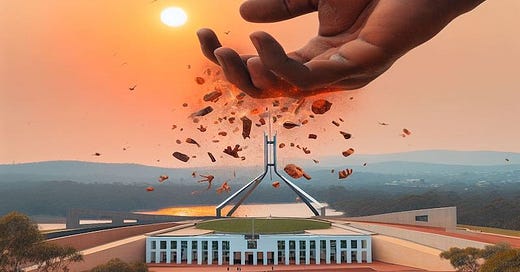Is it the end of the road for Reconciliation in Australia?
Reconciliation will need to involve a recognition of the truth of the past, negotiating Treaty, and fostering a deeper sense of justice.
The recent rejection of the proposal for the Voice to Parliament in Australia has raised profound questions about the future of Reconciliation in the country. Whether the result of the referendum was a “yes” or a “no”, it was anticipated that the process of reconciliation would continue, regardless of the outcome. However, the resounding “no” vote has cast a pall over the prospects of Reconciliation, leading to a sentiment within the Indigenous community that Reconciliation is, in fact, dead. In order to gain a deeper understanding of this perspective, it is essential to analyze the statements made by prominent Indigenous figures, Marcia Langton and Lloyd Walker, and to consider the broader context in which these developments are occurring.
Langton, a respected Indigenous academic and advocate, expressed a deep sense of disappointment in the wake of the referendum’s failure, seeing it as a missed opportunity for Australia to formally recognise Indigenous people in the Constitution and to provide them with an advisory body to Parliament, a body which would have been instrumental in addressing the myriad disadvantages faced by Indigenous communities. The rejection of this proposal, in her view, reflects a failure on the part of the majority of Australians to overcome their colonial biases and recognise the existence and rights of Indigenous Australians. Langton also criticised the “No” campaign for poisoning public opinion against this proposition and against Indigenous Australia.
Walker, another Indigenous leader, acknowledged the efforts made to push the proposal forward, particularly by Prime Minister Albanese, but he recognises the difficulties that lay ahead for the Reconciliation process. He also highlighted the fact that while the “no” vote represented a significant percentage, there remained a substantial portion of the population that supported the proposal, suggesting that progress had been made, even if it was not enough to secure a victory.
The rejection of the Voice to Parliament has exposed the inherent challenges in the Reconciliation process in Australia where, historically, Reconciliation has been driven and defined by the non-Indigenous community, leaving Indigenous peoples with little agency in shaping the terms and conditions of Reconciliation.
This referendum offered a unique opportunity for Indigenous people to express what they wanted in the Reconciliation process, but the resounding rejection by the Australian electorate symbolises a harsh reality – a reality that Indigenous communities had asked for something meaningful and significant to them, and received nothing. The result highlights the significant divide between the broader Australian population and the Indigenous communities, further complicating the path toward Reconciliation.
The outcome has left a sense of disillusionment within the Indigenous community, with some believing that Reconciliation is now “dead”. The rejection of the proposal for a Voice to Parliament underscores the difficulties and challenges that continue to impede the reconciliation process. However, it is important to acknowledge voices like Lloyd Walker’s, which hold onto hope and believe that while it may be difficult, Reconciliation is not impossible.
The rejection of the proposal has also led to a shift in the Indigenous community’s perspective, with some realising that even an inadequate step like the Voice to Parliament was at least a step in the right direction. The path forward remains uncertain, and the Indigenous community will undoubtedly play a pivotal role in determining how Reconciliation evolves in the years to come.
Reshaping Reconciliation: State-level Treaty initiatives and truth telling
While there is a strong belief within the Indigenous community that a federal Treaty is the best avenue for Reconciliation, the current landscape – following the defeat of a very modest and minor Constitutional amendment – suggests that the Treaty process may be more viable at the state and territory levels. This notion is supported by the fact that several states, such as Victoria, Queensland, and Western Australia, have already commenced their treaty processes. South Australia, too, is in the process of setting up its own Voice to Parliament, indicating a commitment to addressing Indigenous issues and concerns.
One of the striking aspects of these state-level treaty initiatives is that they do not require referendums, and governments at the state and territory levels have proactively initiated these processes, demonstrating a more flexible approach to addressing Indigenous issues compared to the federal government. Notably, the Queensland Liberal–National Party’s decision to withdraw support for the treaty process after the referendum results highlights the shifting landscape and the challenges that lie ahead for reconciliation.
Moreover, the historical context surrounding the establishment of Colony of New South Wales on Invasion Day in 1788 has introduced legal complexities to the Treaty process. While there are some discussions about Treaty in New South Wales, the Premier, Chris Minns has announced that nothing will be progressed in this field until after the 2027 NSW election. But should any Treaty be first established in New South Wales, as it was this colony that instigated the annexation and theft of Indigenous land 235 years ago?
The Australian Constitution includes a provision for the acquisition of property by the Commonwealth on just terms, outlined in Section 51. However, this provision is complicated by the fact that the land upon which Australia was federated in 1901 had already been stolen from Indigenous peoples for 113 years. Negotiating a treaty for New South Wales would entail addressing the dispossession and land theft that occurred in the colony’s early history, making it a legal and historical quagmire that demands resolution.
Nevertheless, the Treaty process, whether at the state or federal level, appears to be an inevitable and essential step toward Reconciliation. It is becoming increasingly clear that Indigenous communities are asserting their right to shape the terms of Reconciliation and to secure recognition and justice for past wrongs. The rejection of the Voice to Parliament proposal at the federal level has underscored the urgency of these issues and the need for an evolving approach to reconciliation.
There is also the concept of “truth telling,” another critical component of Reconciliation. Truth telling, as outlined in the Uluru Statement from the Heart, involves recognising the truth of Australia’s history since colonisation and formally acknowledging the injustices, violence, and suffering that Indigenous communities have endured.
While some may resist confronting this history, truth telling is a fundamental step in the healing process and in bridging the divisions of the past. Historical documents, accounts of frontier wars, and the origins of place names all contribute to this process, but there is a need for a formal truth-telling commission to make these accounts official and to facilitate a broader understanding of Australia’s history. How did Slaughterhouse Creek in New South Wales get its name? Or Murdering Gully in Victoria? Both were scenes of massacres of Indigenous people – around 50 people near Moree in 1838, and around 40 near Camperdown in 1839. How many people are aware of these histories?
However, as with the Treaty process, truth telling does not require a constitutional referendum to initiate. It can be set in motion without the need for a nation-wide vote, offering a more flexible and immediate avenue for addressing historical injustices.
The emergence of state-level Treaty processes and truth-telling initiatives indicates a shifting landscape and a growing commitment to addressing Indigenous issues and historical injustices. The future of Reconciliation in Australia will likely involve a combination of local, state, and federal efforts to recognise the truth of the past, negotiate treaties, and foster a deeper sense of unity and justice in the nation.
To effectively advance this agenda, it is crucial for governments to demonstrate their sincerity, engage with Indigenous communities, and address the concerns of the broader population to create a more inclusive path forward.
Charting a new course: Strategies for advancing Reconciliation in Australia
One of the central themes in the aftermath of the referendum is the need for governments and advocates to adapt their approaches. While the Voice to Parliament proposal had a target on its back from the moment Anthony Albanese announced it on election night in May 2022, the Treaty process in states like Victoria demonstrates that governments can take proactive steps to address Indigenous issues without the need for a referendum. The quiet progress made in Victoria, in particular, serves as an example of how governments can move forward with projects without excessive fanfare, ensuring that they align with the Reconciliation agenda.
One of the core points emphasised by the “No” campaign was the presence of 11 federal members of parliament and Senators, leading to their question of why there is a need for a Voice to Parliament. Their arguments can, in turn, be used against these opponents: if that’s their argument, then governments should proceed to utilise these MPs and Senators and establish an Indigenous working group equipped with the necessary resources, funding, and support needed to advocate effectively. How could these opponents then disagree with this approach, considering it aligns with what they’ve essentially called for?
The rejection of the Voice to Parliament – as difficult as this is for many in the Indigenous community and “Yes” campaigners to accept – should not be viewed as an insurmountable setback but rather as a call to adapt and innovate. Indigenous communities, like many other marginalised groups, often face resistance to change and are subjected to stereotypes and biases. In this context, to achieve goals and agendas, Indigenous advocates can work strategically, laying low when necessary and seeking opportunities to make changes in ways that may not attract widespread attention but do get the job done.
Moreover, Reconciliation should not be a one-sided effort and solely on the terms of non-Indigenous Australians, and there needs to be a confrontation of their own biases and engagement in open dialogues to foster a sense of unity and shared responsibility. It is a challenging path, but Reconciliation demands a willingness to confront historical injustices and embrace the diversity that enriches the nation. This involves a collective introspection that transcends the divisions of the past.
In hindsight, the campaign for the Voice to Parliament referendum faced several challenges. The timing of announcing the referendum and setting the date allowed misleading information to take root, while the messaging lacked the simplicity and resonance that could have appealed to a broader audience.
Looking forward, there may not be another referendum on Indigenous recognition for several decades. In the meantime, it is vital to analyse the failures and lessons from this campaign and apply them to future efforts. Australia is a diverse and evolving nation, and the path to Reconciliation will require ongoing adaptation, innovative strategies, and collaboration between all segments of society.
The rejection of the Voice to Parliament proposal is undoubtedly a setback, but it is not the end of the Reconciliation journey in Australia – or, at least, it shouldn’t be. Governments, advocates, and the broader population must adapt and find new ways to advance the Reconciliation agenda. By embracing creative solutions, utilising the Indigenous voices already in Parliament, and promoting unity and shared responsibility, Australia can continue the path toward Reconciliation and justice for Indigenous communities. The challenges are formidable – as they always have been – but they are not insurmountable, and the quest for Reconciliation remains a shared commitment.









